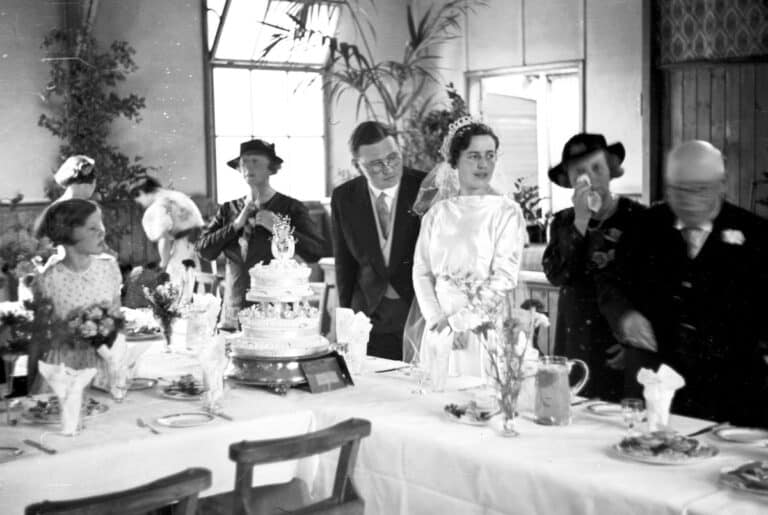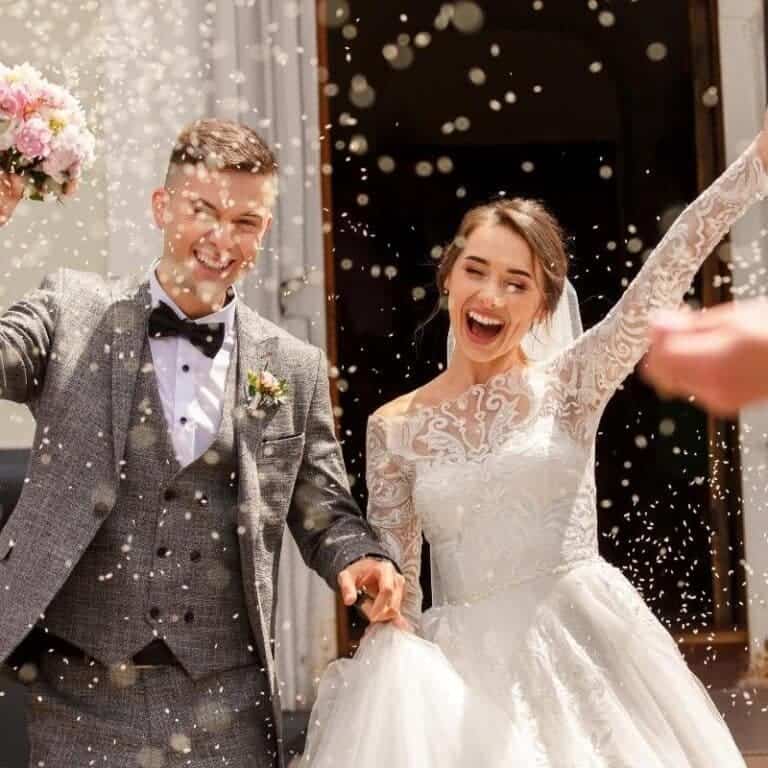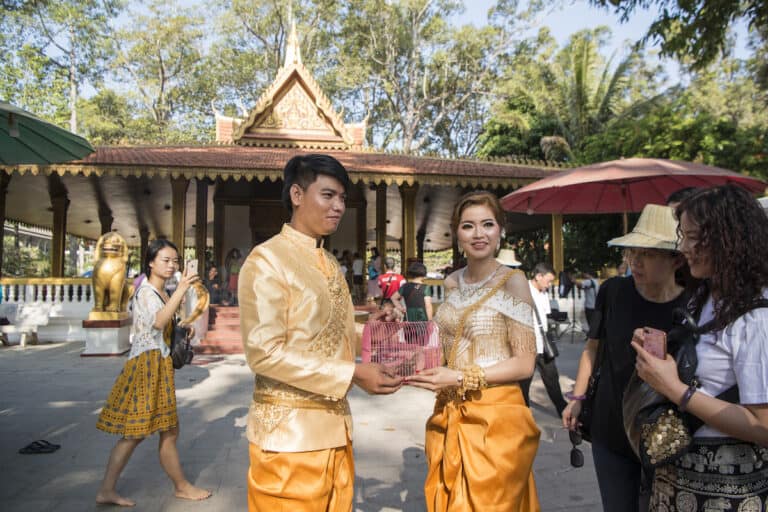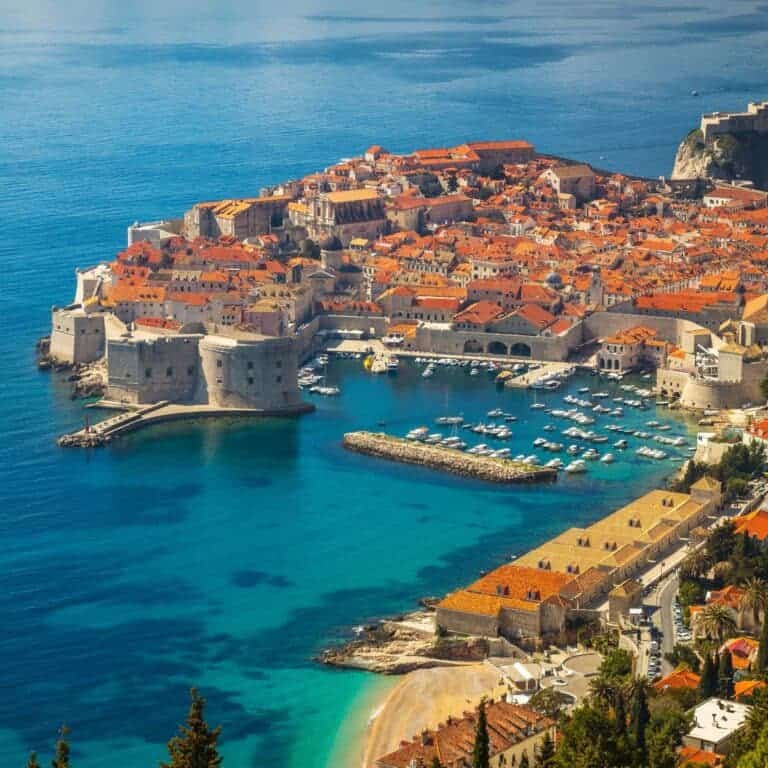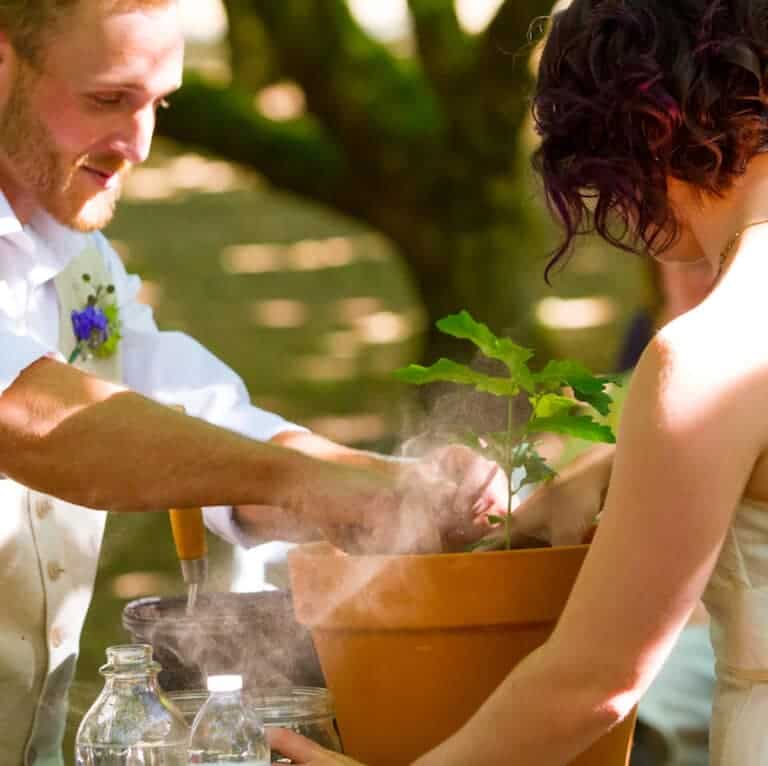Scottish Wedding Traditions
Scotland is a country rich in cultural heritage. When it comes to wedding traditions, some customs practiced today have origins as far back as the 13th century and are therefore steeped in tradition and superstition.
Many of these traditions originate from Celtic or Gaelic practices and beliefs. For example, Gaelic tradition states that marrying in May or during a waning moon is unlucky. Customs also vary in different parts of Scotland. For example, a tradition from Aberdeenshire is for the bride’s father to place a silver coin, usually a sixpence, in the bride’s shoe as a good luck charm.
However, on the Scottish Borders, a sprig of white heather is traditionally hidden in the bride’s bouquet for good luck. Additionally, some remote islands in the Hebrides observe Celtic wedding traditions and superstitions that are now unique to their culture. In this article, we will discuss a variety of Scottish traditions and beliefs that have helped to shape these traditions.
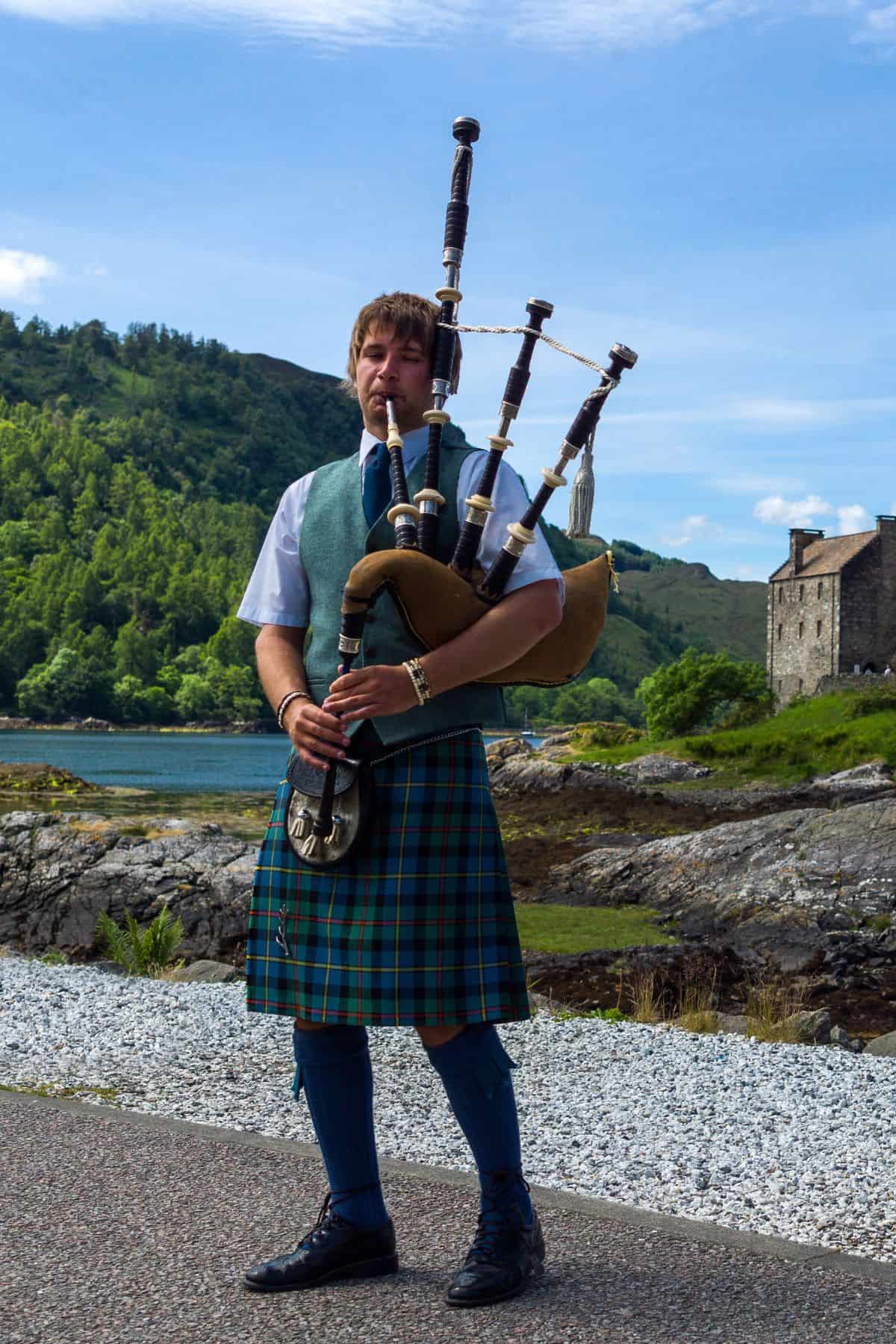
Scottish Wedding Attire.
Scottish wedding attire is steeped in tradition and history. It is often a combination of formal and cultural elements that reflect Scotland’s rich heritage.
Man’s attire
Here are some of the traditional Scottish wedding attire pieces worn traditionally by men
- Kilt – The kilt is a knee-length garment made of tartan fabric. It is the most iconic piece of Scottish clothing and is often worn by the groom and groomsmen. Kilts come in various tartan designs, representing the different Scottish clans.
- Prince Charlie Jacket – This is a traditional jacket worn with a kilt. It is a formal jacket with tails and is typically made of wool and silk. The jacket is often worn with a waistcoat or vest.
- Sporran – A sporran is a small pouch worn around the waist. It is typically made of leather and decorated with fur or other embellishments. The sporran is used to carry small items like money, keys, or a mobile phone.
- Ghillie Brogues – Ghillie brogues are traditional Scottish shoes worn with a kilt. They are made of leather and have laces wrapped around the ankle and tied in a knot.
- Sgian Dubh – A Sgian Dubh is a small dagger worn in the sock of the wearer’s right leg. It is a traditional piece of Scottish dress and is often used for ceremonial purposes.
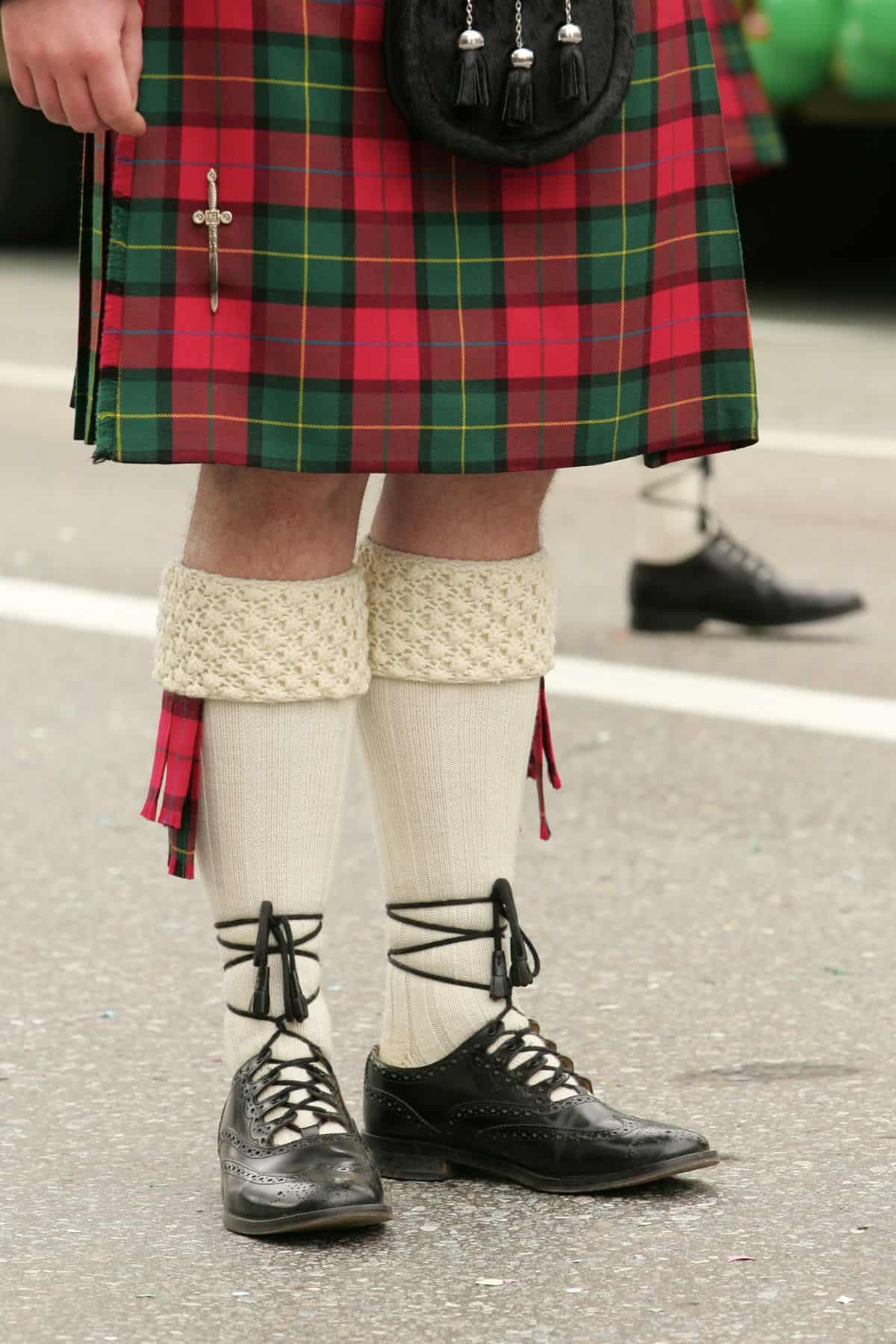
Woman’s attire
Here are some of the traditional Scottish wedding attire pieces worn traditionally by the woman
- Earasaid – or arisaid. Women wore this original Scottish wedding dress from the 18th century in the Highlands. It is a long, rectangular fabric draped over the shoulder and fastened at the waist with a belt or brooch. The earasaid was typically made of wool and could be plain or decorated with a tartan pattern. Traditionally it was a plain tartan, and the colorful patterns were reserved for men. It was worn over a blouse or shirt and could be paired with a skirt or dress.
- Dress – In modern times, the dress worn by the bride is usually white or ivory and can be made of silk or other luxurious fabrics. The dress can be simple or elaborate, but it is often styled with traditional Scottish elements such as lace or tartan details.
- Shawl or cloak – The bride may also wear a shawl or cloak made of tartan fabric. It can be draped over the shoulders or used to cover the head and is a nod to Scottish tradition.
- Tartan sash – A tartan sash is sometimes worn over the dress and draped over one shoulder. It is often made of the same tartan as the groom’s kilt and symbolizes the couple’s connection to Scotland.
- Tartan accessories – The bride may wear tartan accessories such as a scarf, purse, or shoes. These items can be used to add a pop of color or to complement the overall look.

Luckenbooth Brooch
The Luckenbooth brooch is a traditional Scottish brooch typically made of silver and is shaped like two intertwined hearts beneath a crown. It is often decorated with intricate Celtic knotwork, thistles, or other traditional Scottish designs.
The Luckenbooth brooch is often given as a token of love and affection, particularly between couples. It is also worn as a symbol of Scottish identity and cultural pride. In the past, women often wore it to ward off evil spirits and protect newborn babies.
The name “Luckenbooth” comes from the Old Scot’s word “lucky,” which means “locked.” The brooch was initially sold from locked booths in Edinburgh’s Royal Mile, which were also used to sell other trinkets and curios.
Today, the Luckenbooth brooch remains a popular accessory, particularly for Scottish weddings or other special occasions. It is often worn on a kilt or pinned to a sash, shawl, or scarf. The brooch is a beautiful, timeless piece of Scottish jewelry representing love, tradition, and cultural heritage.
Wedding walk
Traditionally, the wedding party formally marches to the church on the big day. Bagpipes are played as the bride and groom walk down the aisle or make their way to the wedding reception.
Custom and traditional beliefs also state that brides should put their right foot forward first when leaving their homes to march to the wedding venue. This was seen to bring good luck.
There are a number of other traditional beliefs around things that may bring bad or good luck on the wedding walk.
For example, it was seen as unlucky to meet a pig or a funeral procession on the march. If this happened, the procession would have to start the march again from the beginning.
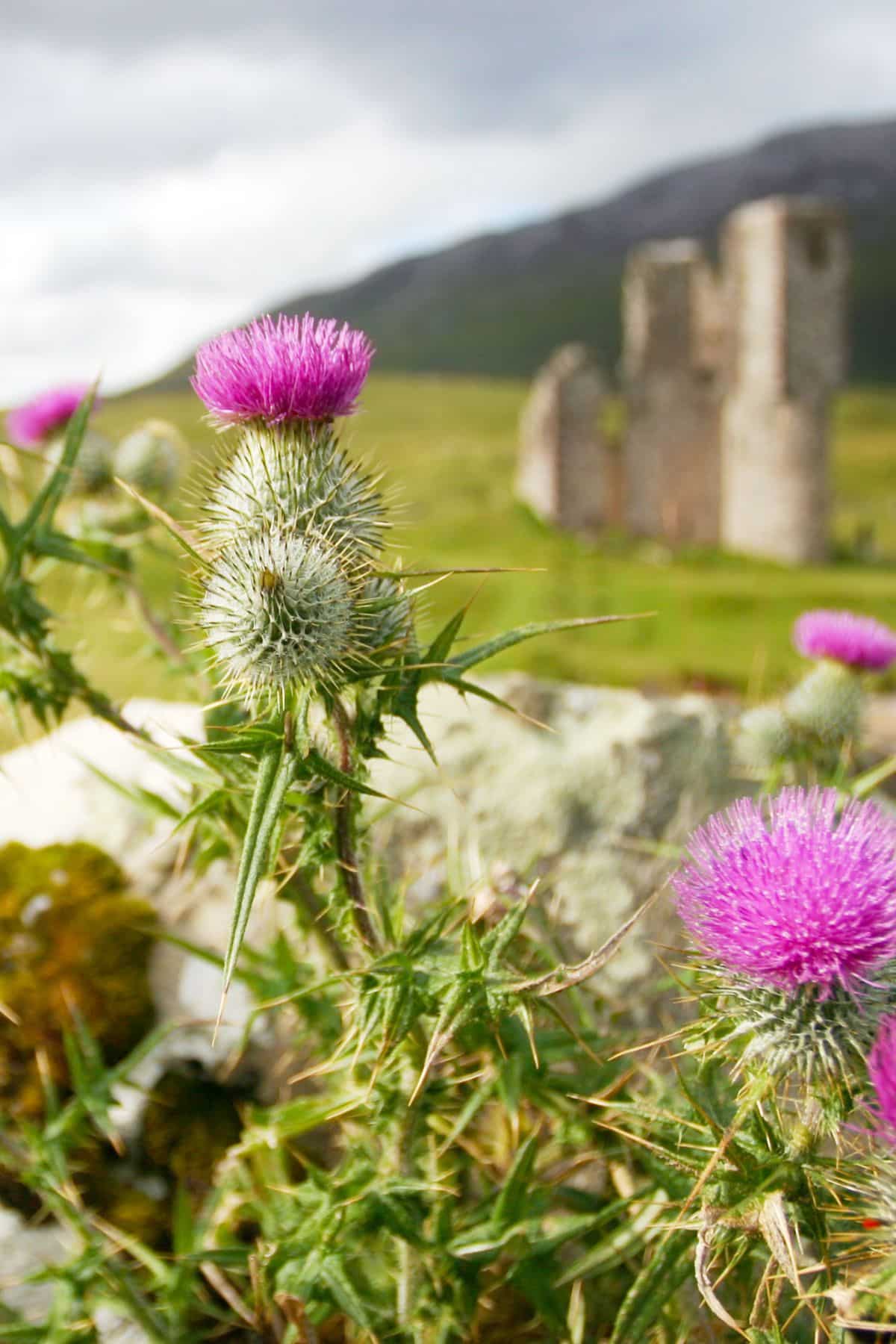
Feet washing
Feet washing is a traditional Scottish custom that some brides still participate in before their wedding. This custom sees a member of the bride’s family, traditionally a married female member, washing the bride’s feet on the wedding day.
The tradition originated in Fife, and although it originates in ideas of purity, it is now seen as more of a symbol of good luck.
A Quaich
Drinking from a quaich is a traditional Scottish wedding ritual. A quaich is a two-handled drinking cup often made of silver. It is a symbol of friendship, hospitality, and togetherness.
During a Scottish wedding feast, the bride and groom may be given a quaich filled with whisky or another traditional Scottish drink. The happy couple may take turns sipping from the cup, using both hands to hold the handles. This act symbolizes their commitment to sharing everything in their lives, both the joys and the challenges.
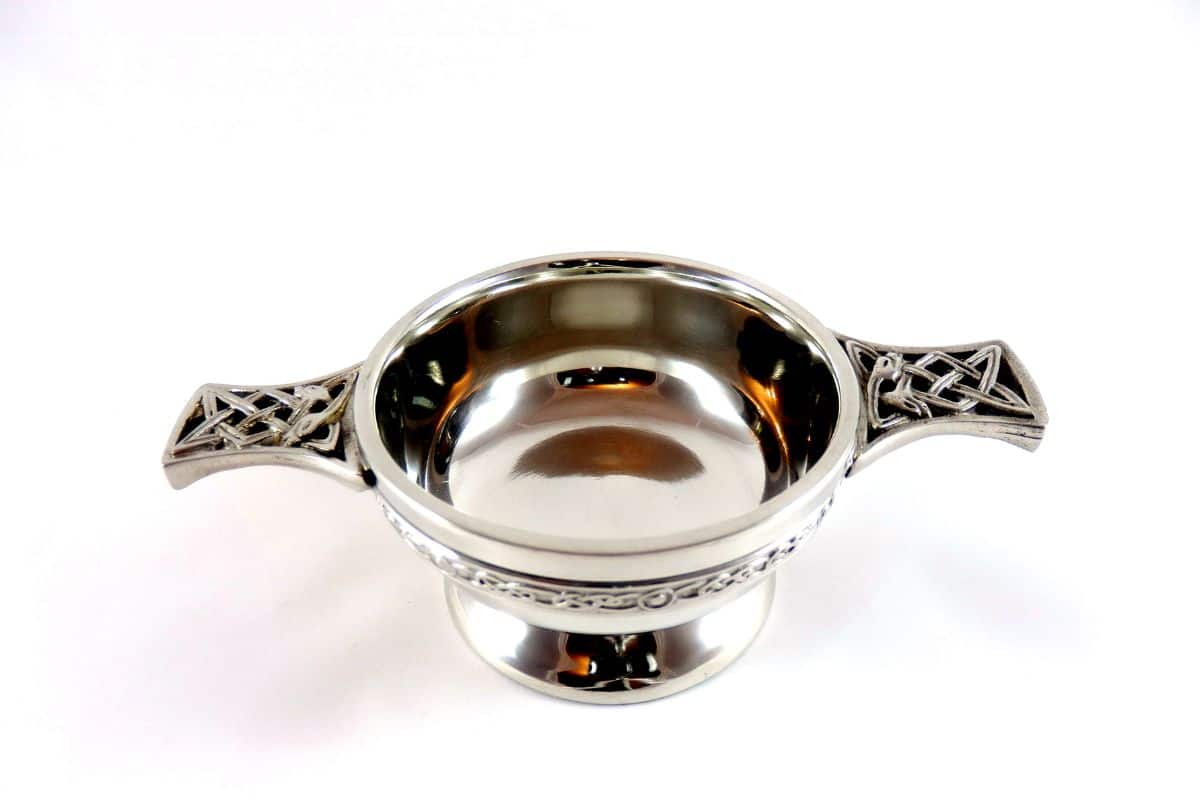
Scramble
Another traditional custom is a Scamble, whereby the bride’s father would throw a handful of coins out of the wedding car into the street for neighborhood kids to pick up. This is not practiced as widely today but may still be found in more traditional weddings.
Tying the knot
As mentioned, many Scottish wedding traditions originate from Celtic practices. For example, the term ‘tying the knot,’ a widely used term for getting married today, originated in Scotland. This custom, often called hand-fasting, began in medieval times but is still practiced today.
During the wedding ceremony, the couple both provide a strip of cloth, often their clan tartan. The celebrant then positions the couple’s hands together and ties them together at the wrist, symbolizing their commitment. Couples sometimes keep the knot tied in the hand-fasting ceremony as a physical representation of their marriage.
Historically, this ancient tradition has a darker side. The handfasting ceremony meant that if the bride had not become pregnant or had a child within one year and one day of the ceremony, the husband could divorce her immediately.
Wedding rings
The custom of wearing wedding rings on the ‘ring finger’ originates in Roman times. Romans believed in the vena amoris, a vein of love running from the left hand’s fourth finger, now known as the ring finger, to the heart.
This custom is observed all over the world, including Scotland. One Scottish tradition states that the bride should have one wedding ring for everyday wear and another, more expensive, dress ring.
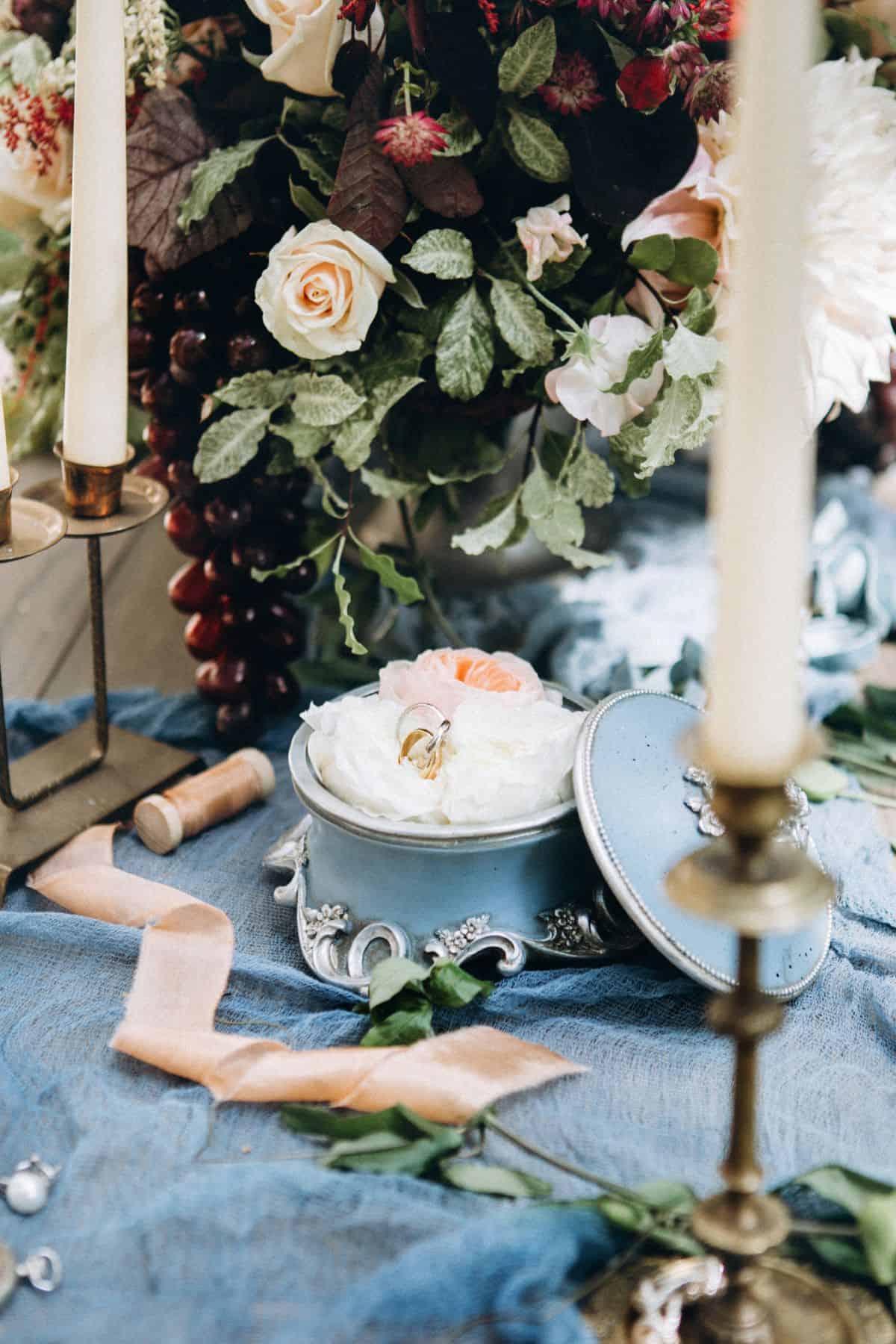
Music
Many Scottish weddings have a piper playing the bagpipes. The bagpipes are a traditional Scottish instrument. Having a piper at a wedding reception is considered lucky.
Historically, the skirl of the bagpipes, or the shrill sound that the pipers produce, was thought to ward off evil spirits, protect the couple, and bless the marriage. For this blessing to occur, the bride and groom must pay the piper with a dram of whisky.
‘Mairi’s Wedding’ is a popular song to hear at a Scottish wedding, as well as ‘500 Miles’ by the Proclaimers!
Dancing
The traditional grand march tends to be the first dance to take place at a wedding reception. In the grand march, the bride and groom march to bagpipes or to a live band.
One of the most fun traditions in Scottish weddings is the Ceilidh. The word ‘ceilidh’ descended from the Gaelic word for ‘gathering’ or party’; however, when people think of a Ceilidh, they tend to think of ceilidh dancing. A ceilidh dance is something that everyone can take part in. A live band guides it, and dancers are walked through the steps, so they don’t have to be experienced to have a great time. Traditionally, dances like the Gay Gordon and Orcadian Strip the Willow will be performed at a Scottish Wedding.
The Lang Reel, a tradition mainly practiced in fishing communities in north-east Scotland, sees the wedding guests dancing through the village, each couple leaving the reel when they arrive at their homes, leaving the newlyweds to have the last dance.
Gretna Green
When discussing weddings and Scotland, it would be a shame to leave out Gretna Green. Gretna Green is an area on the border between Scotland and England. It is famous for being a destination for eloping couples and a haven for young lovers. Until 1977, anyone under 21 in England or Wales was prevented from marrying without their parent’s consent.
Young couples would flock over the border to Scotland, where the legal age for marriage was 16. In 1977, the legal age for marriage without parental consent in England and Wales changed to 18. However, there is still a ‘Gretna gap’ between the two legal systems.
To this day, people go to Gretna Green to get married, if not only for its interesting history.
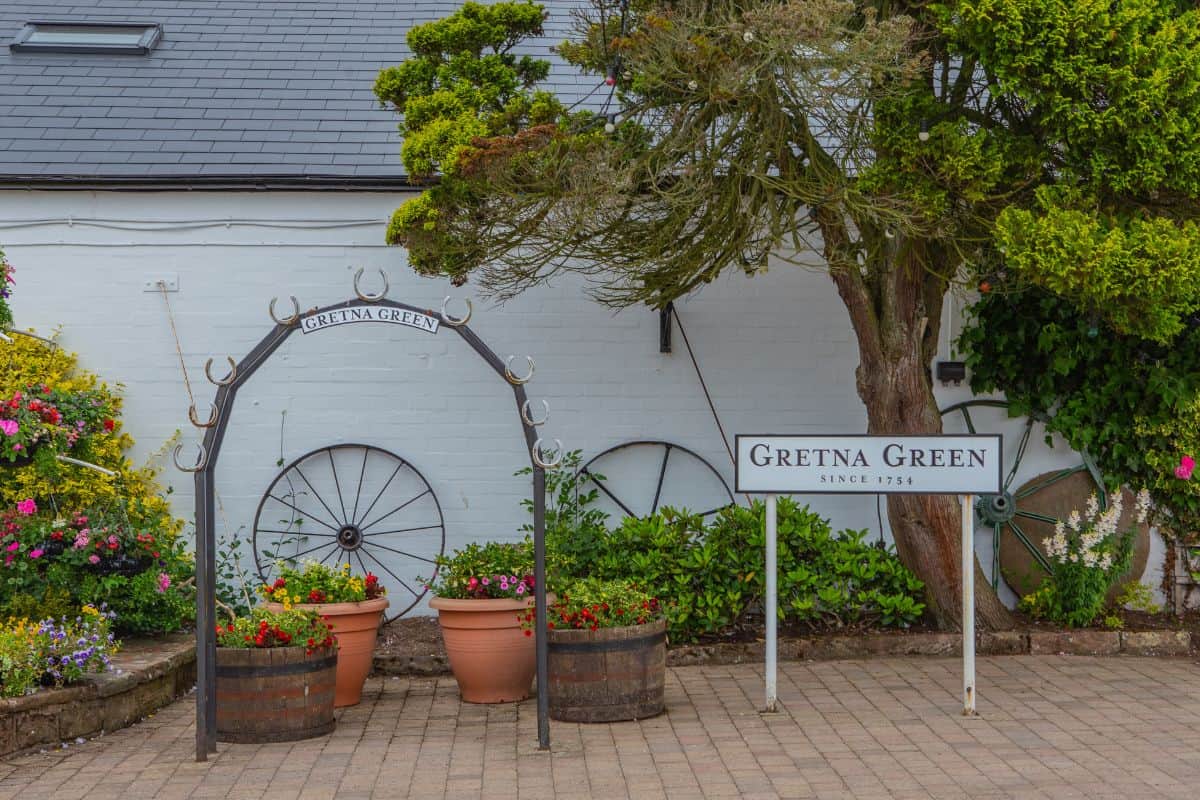
Pinning the Tartan
Pinning the tartan is a traditional Scottish wedding ritual that represents the joining of two families through marriage. It involves the bride and groom each being presented with a piece of tartan from their respective families. These are then pinned together to create a new family tartan.
During the pinning of the tartan ceremony, the bride and groom may be presented with a length of tartan fabric by their respective family members. The tartan may be draped over the couple’s shoulders and then pinned together with a decorative brooch or pin. This act symbolizes the merging of two families into one.
The tartan is an essential symbol of Scottish culture and heritage. Each clan or family has its unique tartan pattern.
The Speerin
The Speerin is a traditional custom that takes place before the wedding. It involves the groom-to-be completing tasks given by the bride-to-be’s father.
If the prospective groom completes these challenges, he earns the approval of the bride’s father.
The Selkirk Grace
The Selkirk Grace is a traditional Scottish prayer recited before the wedding meal. The prayer is named after the town of Selkirk, located in the Scottish Borders region.
The Selkirk Grace goes as follows:
“Some hae meat and canna eat,
And some wad eat that want it;
But we hae meat, and we can eat,
And sae the Lord be thankit.”
Translated into modern English, the prayer means:
“Some have meat and cannot eat,
And some would eat that want it;
But we have meat, and we can eat,
And so the Lord be thanked.”
Scottish Wedding Food
Scottish wedding food often includes a mix of traditional and modern dishes, with an emphasis on hearty, flavorful cuisine. Some popular Scottish wedding food options include:
- Haggis: A traditional Scottish dish made from sheep’s organs, oatmeal, onions, and spices. This is often served as an appetizer.
- Cullen skink: A creamy soup made from smoked haddock, potatoes, onions, and cream.
- Cock-a-leekie soup: A soup made with chicken, leeks, prunes, and barley.
- Neeps and tatties: A side dish made from mashed turnips and potatoes.
- Salmon: Scotland is known for its fresh and delicious salmon, which is often served at weddings.
- Venison: Another popular meat in Scotland, venison is often served as a main course at wedding receptions.
- Shortbread: A classic Scottish dessert made from butter, sugar, and flour.
- Cranachan: A dessert made from whipped cream, raspberries, honey, and oatmeal.
- Whisky: As Scotland is famous for its whisky, it is often served as a drink option at weddings.
In addition to these dishes, many Scottish couples also incorporate their own personal favorites or family recipes into the menu. Scottish wedding food is often hearty and filling, designed to keep guests satisfied throughout the long celebrations.
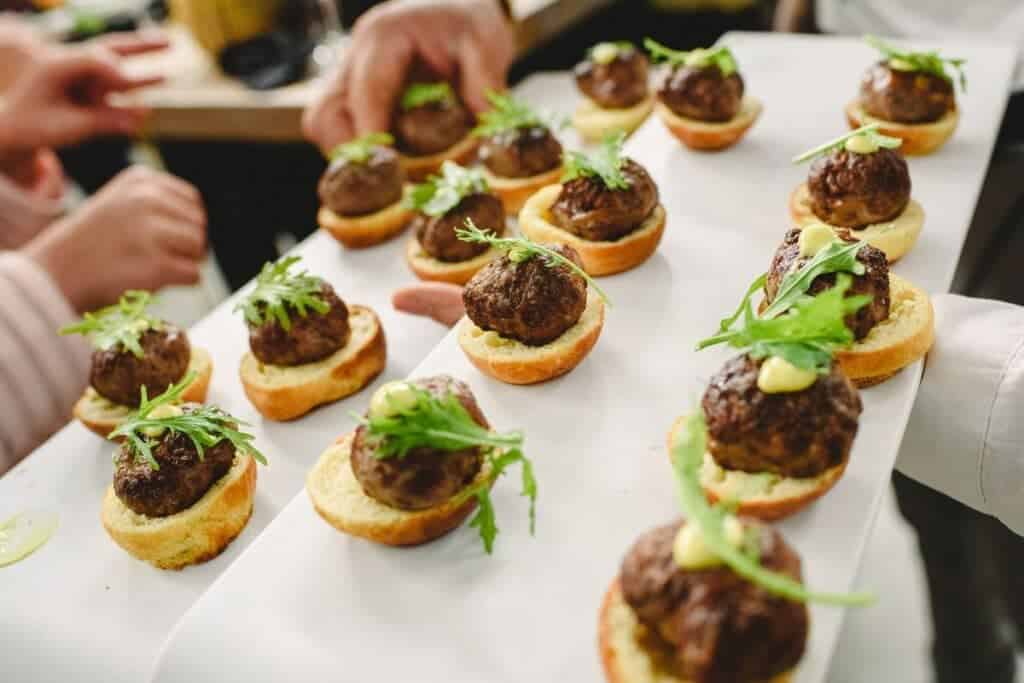
The wedding cake
The traditional Scottish wedding cake is a rich and dense fruitcake. It’s made with dried fruit, nuts, spices, and a generous amount of whisky.
It is typically round or square and covered in white icing, with intricate designs made from icing or marzipan.
Final thoughts
The Scots have always profoundly respected their ancestors and customs, and many of these traditions have been passed down through the generations. Today, many couples choose to incorporate these traditions into their weddings to honor their heritage and create a unique and memorable celebration.
Whether it’s the handfasting ceremony, the wearing of the tartan, or the sharing of a quaich, Scottish wedding traditions offer a beautiful way to celebrate love, commitment, and the bonds of family and community

